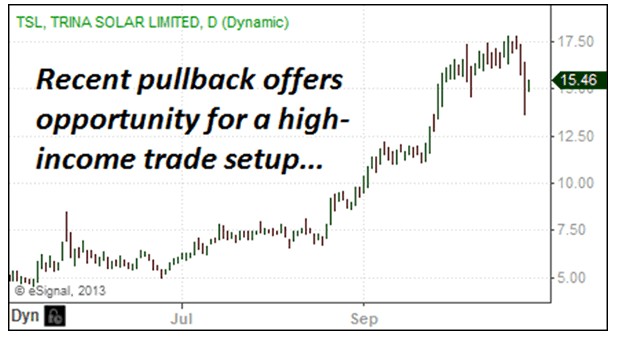Believe it or not, solar stocks have been some of the best performers in the second half of 2013.
?
Earlier this year, analysts began to see an uptick in global demand for solar energy as Japan began transitioning from nuclear power to renewable energy, and other developed nations began increasing purchases of solar energy components.
Last quarter, a number of high-profile solar companies reported increasing shipments of solar panels, and this led to a significant rise in stock prices.
This rally was from a very depressed base, due to weakness over the past several years that was caused by overcapacity, an inventory glut and falling prices for solar components. A number of solar manufacturers were put out of business or forced to merge with competitors due to the challenging environment.
At this point, it is a bit difficult to determine how high solar stocks could ultimately trade, because there is so much uncertainty regarding future profits. Aside from industry leader First Solar (Nasdaq: FSLR), most solar manufacturers are still operating at a loss. But over the next few years, the profit picture is expected to change.
For example, Yingli Green Energy (NYSE: YGE) is expected to cut its loss in half this year, even further in 2014, and could very well turn a profit in 2015. Canadian Solar (Nasdaq: CSIQ) is now expected to earn $0.17 per share in 2013 and $2.61 per share next year. And while Trina Solar (NYSE: TSL) is expected to lose $1.59 per share this year, the company should break even next year and could post a profit in 2015.
Today, I want us to take a look at an income opportunity for TSL based on the healthy trading pattern for the stock and the significant shift in expectations from analysts. As you can see in the chart below, TSL has more than doubled since its breakout in August. The recent pullback gives us a chance to set up an income opportunity with a more attractive underlying stock price and, due to an increase in the stock's volatility, a much higher option premium.

Analysts, for their part, have dramatically shifted their earnings models for the company. Three months ago, the consensus earnings estimate for 2014 was a loss of $0.68 per share. Today, analysts believe that the company will essentially break even next year. Given the dramatic turnaround in the industry, I wouldn't be surprised to see those estimates continue to improve, with TSL very possibly posting a profit next year.
Given the significant shift in expectations, demand for the stock has picked up significantly. Even though the stock pulled back over the past few days, I still think the bullish trend is in place. This pullback should represent a buying opportunity and a great spot to sell put options to capture an attractive annualized yield on the trade.
Today, I recommend selling the TSL Dec 15 puts, currently trading for about $1.68. Each options contract represents 100 shares, so for every contract you sell, you receive $168 in premium. These puts are out of the money, meaning the current market price of the underlying stock is above the strike price. As long as TSL remains near its current price, these puts will expire worthless in 52 days and we will not be obligated to buy the stock.
Of course, if shares trade lower and remain below $15 when the puts expire, we will be required to buy 100 shares of TSA for every contract sold at $15 per share. But given that we received $1.68 per share from selling the puts, the net cost will actually be $13.32, which is more than 13% below the current price, costing you $1,332 per options contract sold.
This is a great way to set up a trade where we may be able to purchase shares of TSL at a significant discount or generate an attractive amount of income over the next seven weeks.
If the put options expire worthless, we keep the $168 premium as profit, earning a potential 12.6% return on the $1,332 we set aside. If you annualize that type of return for a year, you get a rate of return of 88% per year.
Of course, this is a unique situation and there is no guarantee that the stock will remain above the $15 strike price. But selling puts on quality stocks following a pullback can be a great way to set up high-return income opportunities.



